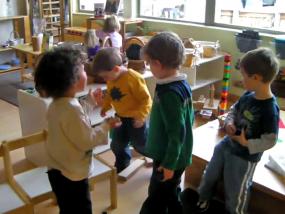Breaking to Build - Boys and Blocks

Dusk and his friends are interested in building a track for their racecars. As a provocation, some of the chairs are lined up in the classroom. The children see this line of chairs as a good location for their track. Dusk decides to extend the line of chairs and recruits his friends to help. Listen as he repeats the words “more, more, more!” Watch how Marty responds and how the boys get to work, spurred on by Dusk’s motivational speaking throughout the footage. Dusk gathers his friends to explain where to build the track and what to do once the track is finished. He outlines the work and entices his friends with the thrill of what it will be like when the track is complete. These boys have built many tracks, but they have never constructed a track under the chairs before.
Dusk thinks about the materials that the group will need and realizes that many of the blocks are being used in the block area. He understands that he must talk to his friends and convince them to break down their previous work with the blocks in order to move ahead with the racetrack project. His friends listen to him but are easily distracted. Dusk repeats his goals to his friends as their attentions wander. He cannot come up with a name for what he wants to build. Roarke listens to Dusk and helps him clarify his desire to break down the blocks in order to build a “racetrack.” Dusk understands that Roarke can be a key player in the progress of this construction.
Once all of the boys have given Dusk permission to proceed, they have fun breaking down the block structure near the window. While the boys are confined to a small area of the room, Dusk announces that they can continue to build their racetrack. Their spirits are high, and they understand Dusk’s vision. They begin to place the blocks under the chairs, end to end. Roarke shows Dusk his strategy of selecting the “big blocks” when building the track. Dusk confirms that the big blocks are the best choice. He connects the word “big” from “big block” to “big idea”. Perhaps this clever play-on-words will motivate his friends to continue working on this project. Perhaps Dusk is excited that he is able to connect the word big to the literal block and the conceptual idea. His energy and ability to articulate his ideas continues to drive the construction of the track.
Dusk notices that someone has made a right-angled turn of the track, beyond the line of chairs. He did not plan on continuing the track in this way, so he breaks the unplanned turn in the track. He attempts to convince his friends that they do not need an extended track that goes around the table. Roarke insists that they do need this extension and repeatedly puts a block back to where he feels it should go, replacing the block that Dusk takes away. Dusk submits to Roarke’s decision, negotiates a comprise for a shorter path and truly embraces the plan for an extended track when he recognizes it will create a “rectangle”. Dusk is excited to make the new track when he discovers its new purpose. With his recognition that the track will be a rectangle, comes Dusk’s enthusiastic repetition of this discovery to his friends, sharing his delight that they are getting more than a longer racetrack.
This episode shows the following about what children and teachers know:
• Teachers know that an environment can be seeded to generate more creative play by using familiar objects in new ways (the chairs abutting in a row) and by providing children with multiple duplicates of these elements (the chairs they can add themselves) and elements that have a large scale (the chairs that have an underneath large enough for laying out the blocks).
• The children know that building a racetrack under a row of chairs creates new challenges and fun. The children deliberately create difficulty. (See our video title, Why Children Make Play Challenging).
• The boys realize that breaking down a block structure is not the same as breaking something that cannot be fixed such as a clay pot. The parts are simply rearranged.
• The boys are aware that a structure of blocks is not the same as a pile of blocks. The child near the structure most likely made the structure and need to grant permission for the undoing of the structure.
• Dusk understands how to motivate his friends by using a clear statement of the goal, even when he cannot come up with the name by himself.
• Dusk realizes that the child who does come up with the name of the goal (“racetrack”) can be a great ally in working toward the goals Dusk sets for the group.
• Teachers know that Dusk’s use of “big” as a modifier for “block” as well as “idea” indicates that Dusk is beginning to appreciate metaphor.
• Dusk’s ability to reframe a violation of his wish into a positive venture moves the project forward. He does this, once again, by coming up with a name for the purpose of the new direction in the block construction, a “rectangle.” In a sense, this is his word, so his friends are, by reason, working for him.
_______ We thank Diana Giattino for her work in developing this videative.
